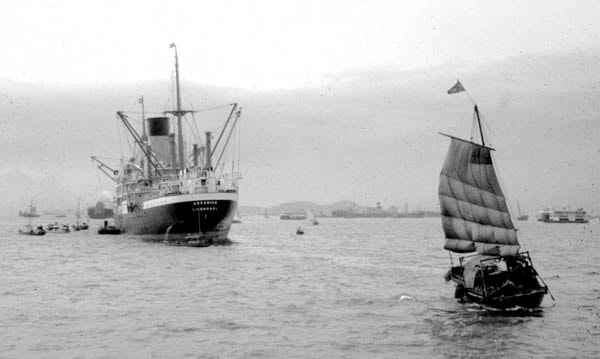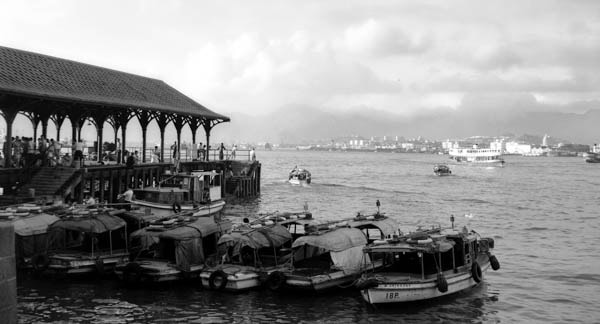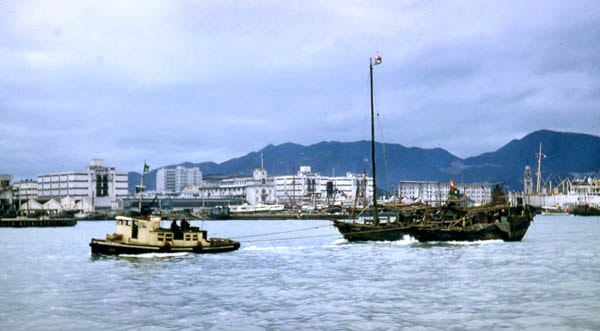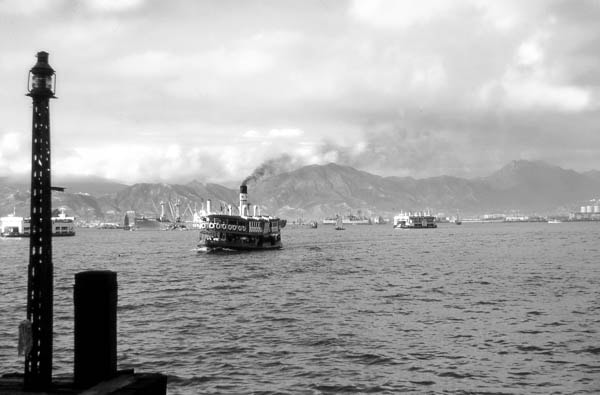Steam vessels were mainly used before the 1960s. Coal was burned to generate steam for powering the earliest steam vessels. Therefore, steamboats in Hong Kong were nicknamed “for shuen tsai” (火船仔) in Cantonese, which literally means “little fire craft”.[30] During the pre-war period, marine hawkers boarded the steamboats and sold daily necessities to seamen on board ocean-going vessels.[31] As steam vessels were not efficient in transporting goods and manoeuvering, motor vessels were then developed and became popular among mariners.

Plate 6: A junk and the motor vessel Ascanius Liverpool, 1956 – a big contrast during the period of industrialisation
Walla-wallas
Most of the motorboats were the products of Hong Kong’s dockyards. For example, a walla-walla, so named because of the noisy sound generated by its engine, was made of timber and had no deck. With a low driving power of around 10 to 20 horsepower, walla-wallas were mainly used to carry people across Victoria Harbour and convey seafarers of ocean-going vessels to the downtown piers. The length of each boat was capped at 20 feet (6 metres), and its maximum carrying capacity was 20 people. Being small in size, the walla-wallas could manoeuvre in the inner waters of Victoria Harbour and Tolo Harbour easily.[32]
In the 1950s and 1960s, walla-wallas played a more significant role in cross-harbour transportation when compared to the earlier post-war years. At their height, there were around 200 walla-wallas in Hong Kong waters in the 1960s. A decade later, in the 1970s, most walla-wallas were double-deckers and could carry both passengers and goods. Walla-wallas also played an important role at night after ferry services had stopped. From 1:30 a.m. to 6:30 a.m., people had to rely on the walla-wallas for crossing the harbour between Queen’s Pier and Tsim Sha Tsui.[33] Such overnight cross-harbour services were vital before the Cross-Harbour Tunnel between Hung Hom and Causeway Bay came into operation in 1972.
Tugboats
Tugs had been in service in the Colony since the late 19th century. They were driven by steam engine and had only 40 to 100 horsepower at the beginning of the 20th century. But as the transport volume increased rapidly as a result of Hong Kong’s economic growth, tugs were no longer used to carry both passengers and goods. They were then only used to carry goods and tug ocean-going vessels until the beginning of the Second World War. At the end of the Japanese occupation, there were no tugs in Hong Kong waters. To spur economic recovery, the colonial government introduced a batch of old tugs from Britain and India. These tugs were driven by diesel. Their engines were from producers like Gray and Perkins, and could provide tugs with 50 to 240 horsepower.[34]
Tugs played a significant role in the expansion of Kai Tak Airport at the beginning of the 1960s. They were chartered by the colonial government to carry huge quantities of construction materials. For environmental reasons, the government banned tugs in designated areas in the mid-1960s. Hence, pontoons became popular for carrying cargo. However, pontoons had to be towed by tugs. So the horsepower of tugs kept rising, and the old 48-horsepower tugs were replaced by tugs with 152 horsepower. Also, by the mid-1960s, pontoons could carry up to 600 tons of cargo.[35]
Ferries
In the mid-1950s, the ferry network grew at a terrific speed. In 1955-56, ferries transported more than 114,000,000 passengers and 1,190,000 vehicles across the harbour and to and from outlying islands.[36] Ten years later, the number surged to over 218,000,000 passengers and 4,125,000 vehicles.[37] In 1955, five diesel-powered vessels joined the cross-harbour services. A year later, four new ferries operated by the Hongkong and Yaumati Ferry Company Limited (HYF) were travelling frequently across the harbour. This showed that mechanically-propelled vessels were commonly used by the commercial sector.[38] In addition, the “Star” Ferry Company put two new diesel ferries into service in 1957, indicating an increase in the number of motor vessels.[39] Apart from four brand-new vehicular ferries and passenger ferries plying in Hong Kong waters in 1965, the HYF converted its traditional vehicular ferries from single-deckers to double-deckers.[40]
With the number of motor vessels increasing by the year, the Marine Licensing Office of the Marine Department took up the responsibility of issuing licences to new craft. Legislative amendments enacted in 1949 revised the 1899 version of the Merchant Shipping Ordinance, inter alia, to enhance the navigational safety of motor vessels.[41] Under the amended ordinance, all motorboats and launches driven by diesel engines would be surveyed and licensed under the new measures introduced by the Marine Licensing Office.
Notes:
- [30]沈嘉穎:《同心同渡50載:港九電船拖輪商會五十周年紀念特刊》(香港:港九電船拖輪商會有限公司,2004),頁80。
- [31]Marine Department Annual Departmental Report, 1950-51, p. 6; The script of an interview with Wong Yiu-kan, Chow Shing-oug, Leung Siu-wing, Wong Kwok-leung, Cheng Paul C. Y.
- [32]沈嘉穎:《同心同渡50載:港九電船拖輪商會五十周年紀念特刊》,頁84-89。
- [33]Ibid., pp. 90-91.
- [34]Ibid., pp. 121-124.
- [35]Ibid., p. 125.
- [36]Marine Department Annual Departmental Report, 1955-56, pp. 7-8.
- [37]Marine Department Annual Departmental Report, 1965-66, p. 40.
- [38]Marine Department Annual Departmental Report, 1956-57, p. 18.
- [39]Marine Department Annual Departmental Report, 1957-58, p. 21.
- [40]Marine Department Annual Departmental Report, 1965-66, p. 57.
- [41]Marine Department Annual Departmental Report, 1954-55, pp. 5-6.





